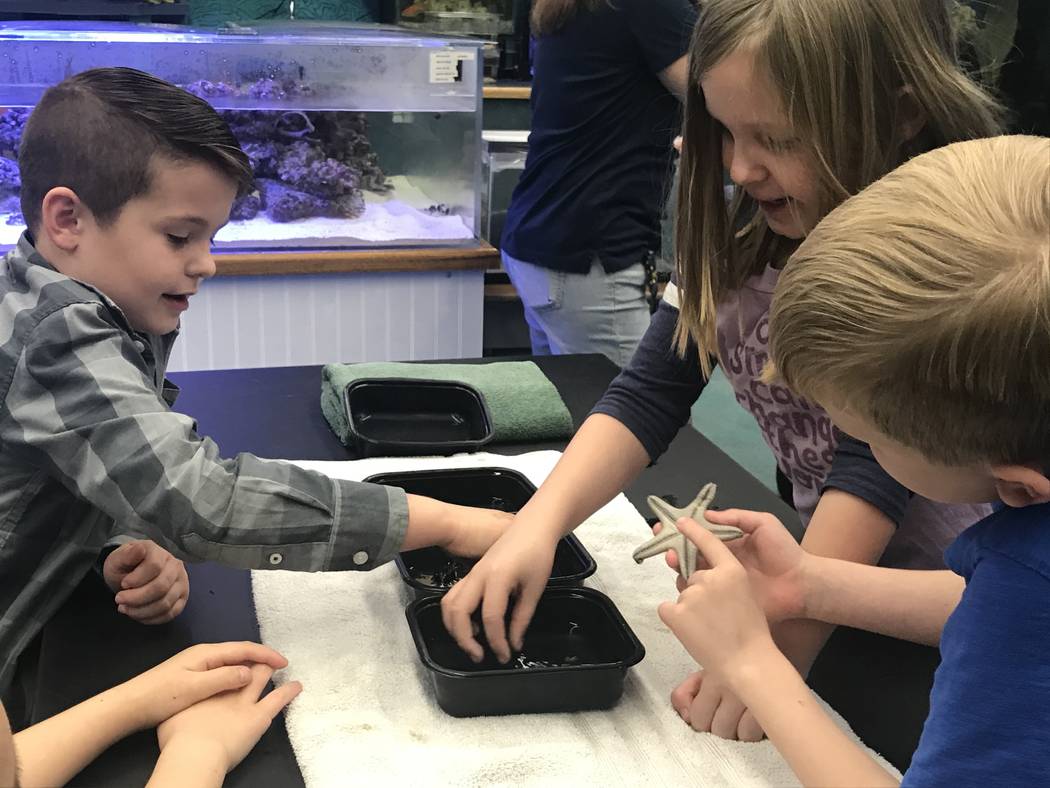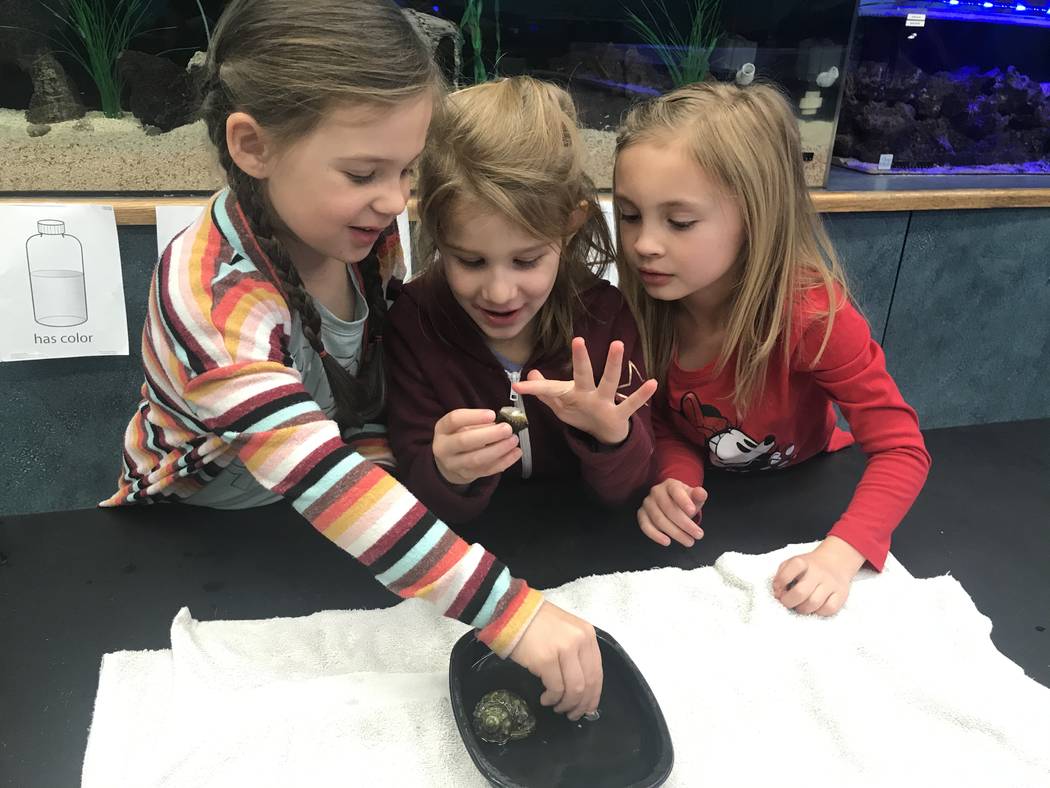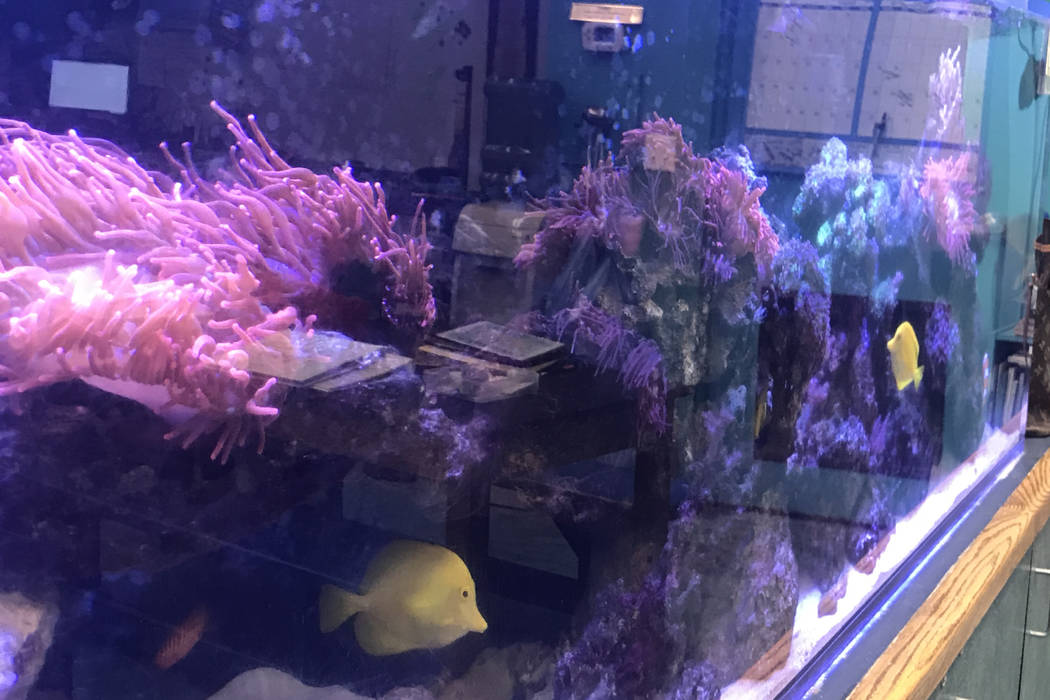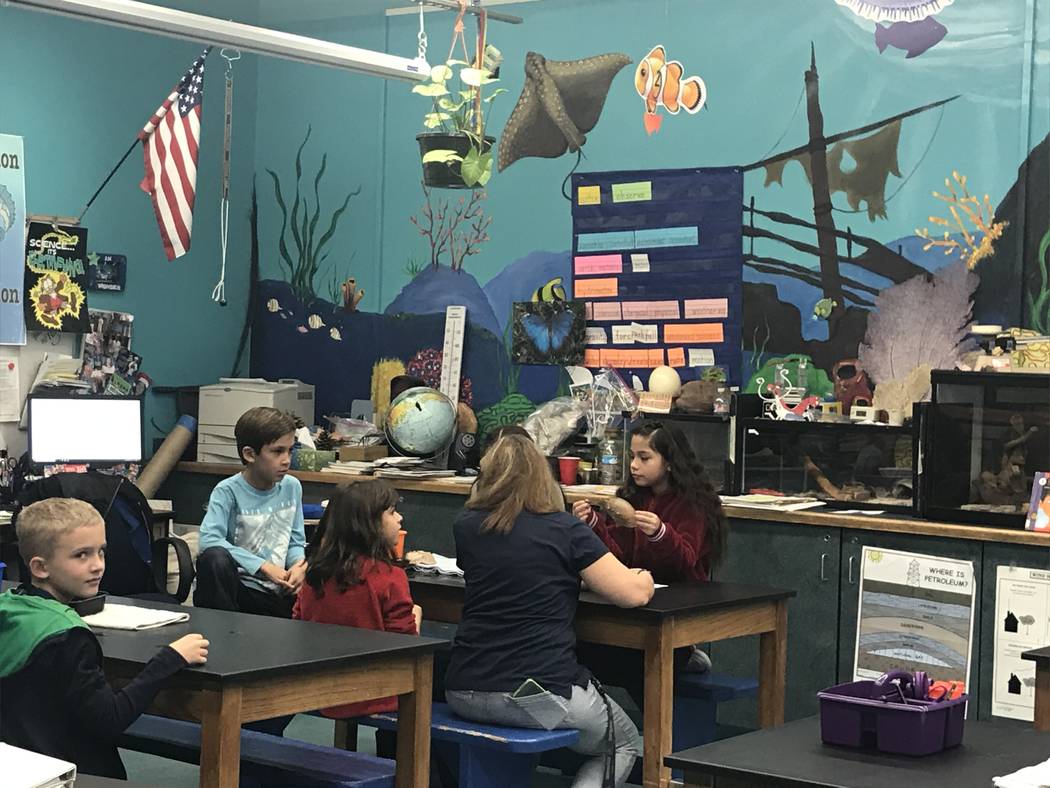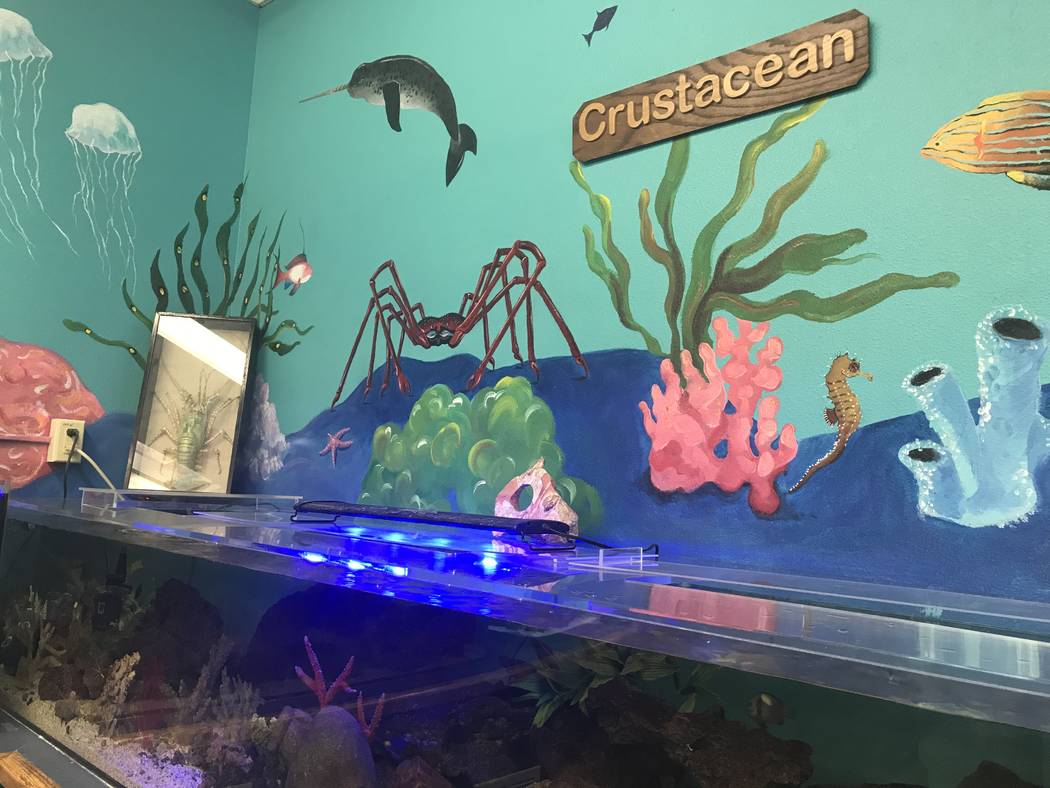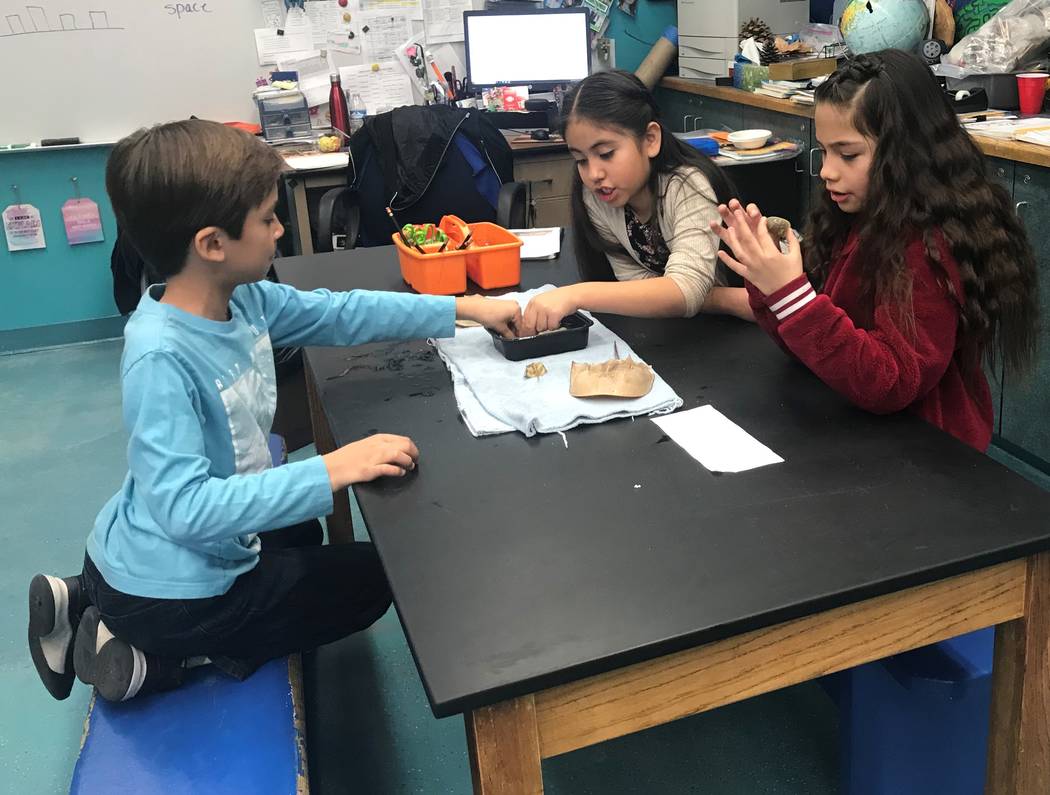Henderson elementary school has marine science lab
Fourth-grader Reagan Calkins likes to visit the fish in her elementary school’s marine science lab each morning.
Her favorite: Sunny the blenny.
On Jan. 16, the 9-year-old was holding a sea urchin at McDoniel Elementary School’s lab in Henderson.
“They have these little spikes and they feel really cool,” she said.
The marine science lab is infused into the Green Valley-area school’s identity. The phrase “bringing the world’s oceans to the desert” is displayed prominently on the school’s website.
The lab, funded by donations, opened in 1989 on the school’s campus. McDoniel Elementary is part of the Clark County School District.
McDoniel Elementary’s PTA raises money to support the marine lab. And the school’s science specialist organizes two fundraisers each year, one of which involves selling tiles children can paint that are displayed outside the lab. Mandalay Bay, which houses the Shark Reef Aquarium, donates salt for the fish tanks.
Kim Adams, science specialist at McDoniel Elementary, said she hopes students take away from their experience in the marine lab “that they need to be caring, concerned citizens of our environment.”
McDoniel students have a science class once a week for 50 minutes as part of a rotation of special classes. Lessons go beyond marine science, Adams said, to include topics such as physical and earth science. For example, third-graders are learning about seeds, plants and hydroponics.
Fifth-grader Lily Rasmussen, 10, was testing water for ammonia Jan. 16 in the marine lab. Lily said she and her classmates are learning about the differences between vertebrates and invertebrates — “what types of animals have backbones or don’t.”
Her favorite part of the marine lab? “I really like the tide pool tank with the sea stars,” she said.
Not all children, though, are excited about touching marine animals.
“I never make a kid hold anything they don’t want to,” Adams said, but she added she’s good at encouraging them to try.
The marine lab isn’t open to the public, but it sometimes receives student visitors — typically, homeschoolers or from charter schools. Visiting children receive a “passport” with a list of things to see in the lab.
Years ago, as many as 1,000 children annually visited the marine lab from other schools, but a grant that funded that program — which included bus transportation — has since ended, Adams said.
To prepare for educating visitors, fifth-graders at McDoniel Elementary have the option of studying to become a tour guide. They must learn about animals such as starfish, sea urchins and hermit crabs.
“They have to have a pretty good handle on what’s in the tanks,” Adams said.
Inside the marine lab
The marine lab is set up like a science lab classroom with clusters of tables and chairs, but the walls are covered by a mural of an ocean landscape. The lab includes 10 saltwater and two freshwater tanks.
Adams buys sea creatures from two or three websites, and they’re shipped. When they arrive, students know about it.
“They know we have new animals and are acclimating them,” she said.
There are signs above some of the tanks, such as “coral reef” and “crustacean.” And there are labels for different species, like snowflake clownfish, on the exterior of the tanks.
The coral reef is the hardest to take care of, Adams said, and it’s the second-biggest tank in the marine lab, with a 240-gallon capacity.
One tank houses a huge batfish who’s a bully and has killed other fish, Adams said. But he’s also the subject of bullying by other fish.
“He’s managed to survive in here,” she said, but noted she’ll eventually have to find him a new home.
The lab is home to a handful of non-marine animals, too, including a snake, hissing cockroaches — not the most popular animal in the lab, Adams says — and tarantulas.
Children learn not to harass any animals in the lab, she said, and they’re not allowed to tap on tanks.
Adams handles changing the water in the tanks, while a parent volunteer — who spends many mornings in the lab — scrubs the tanks and feeds the animals.
The lab’s origins
The marine lab was originally in a portable building at McDoniel Elementary’s campus.
“A few of the schools in the Henderson area wanted to have some additional science input,” Adams said of its beginnings.
The Clark County School District doesn’t fund elementary school science teaching jobs, Adams said, but McDoniel Elementary decided to devote one of its teaching positions to the marine lab.
Adams has been teaching at the school since 1996 and started when her children — now 29 and 26 — were students at McDoniel.
She didn’t have any marine science expertise.
“I learned right along with the students,” Adams said.
The existing marine lab was an addition to the school building and was dedicated in April 1999, according to Review-Journal archives. The school’s PTA raised about $325,000 in private funding — including donations and grants — for the project.
Now, more than 20 years after the existing lab space opened, there aren’t any plans to expand marine lab offerings, Adams said, and there’s not enough space to add more tanks.
And Adams is nearing retirement, “but I don’t know how I can leave,” she said, given that the marine lab has been part of her life for so many years. Beyond the school week, she cares for the animals on weekends, over breaks and during the summer.
She said she hopes there will be a job candidate in the future who’s passionate enough about the marine lab to take the job and learn.
Contact Julie Wootton-Greener at jgreener@reviewjournal.com or 702-387-2921. Follow @julieswootton on Twitter.



